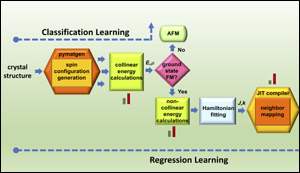High-throughput discovery of 2D magnets
10. 4. 2020 | Indian Institute of Science | www.iisc.ac.in
2-D materials are atomically thin, single-layered films arranged in a crystal structure, which have potential applications in next-generation electronics and optoelectronic devices. Ferromagnetism (FM) in such materials ‒ the mechanism by which they act as magnets ‒ was considered implausible until a few years ago. In 2017, scientists discovered low-temperature FM in 2-D materials, which has led to significant advances in the fields of nanotechnology and electronics.
At low temperatures, ferromagnetic materials are capable of retaining their magnetic properties well. However, the magnetic order in such materials gets disturbed as the temperature increases. The temperature at which materials lose their FM properties is known as the Curie point. Curie point is therefore a critical property of ferromagnetic materials for practical applications. However, determining the Curie temperature involves a set of very complex calculations.

A research team from the Indian Institute of Science (IISc) has now developed an open source computer code to estimate Curie temperatures from the crystal structures of materials. The study, published in npg Computational Materials, combines informatics using open source databases and machine learning to discover as well as predict the Curie temperatures of 2-D ferromagnetic (2DFM) materials.
Read more at Indian Institute of Science
Image Credit: Indian Institute of Science
-jk-




